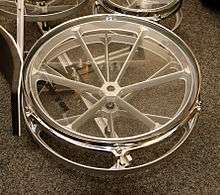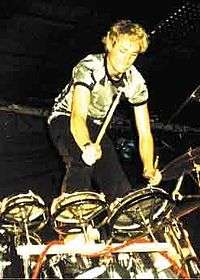Rototom

Rototoms are a drum developed by Al Payson and Michael Colgrass,[1][2] that have no shell and are tuned by rotating. They consist of a single head in a die-cast zinc or aluminum frame. Unlike most other drums, they have a variable definite pitch. Composers are known to write for them as tuned instruments, demanding specific pitches. Rototoms are often used to extend the tom range of a standard drum kit. They were commercialized by the drumhead company Remo.[3]
Sizes
Rototoms are available in seven sizes---6", 8", 10", 12",14", 16" and 18" diameters. Each Rototom can be tuned over an extended range of at least an octave, although the practical range for fullness of sound is approximately a sixth interval. Each size can produce a wide variety of effects, depending upon the drum head used and how it is tuned
Drum Heads
Rototoms are furnished with CS Black Dot drum heads as standard, but may be changed to other heads. Each drum head offers distinctive tonal differences with have unique applications with Rototoms.
CS Black Dot
The special Sound Center reinforcement give the medium weight CS head outstanding compactness of sound with minimum "overring " plus great durability. Preferred by rock and jazz performers for drumset use, as well as for general orchestral indefinite-pitched percussion. Furnished in transparent film with black reinforcement.
PinStripe
The two-ply construction with two layers of Emperor-weight film bonded at the collar offers the ultimate in a dampened tom tom sound-I wet, flat and funky" as demanded by today's rock and jazz performers".
FiberSkyn
The medium weight FiberSkyn head with its specially laminated construction produces a round, dark tom tom sound, somewhat softer than CS head. Its tonal purity is especially suited for recording use and in tuned tom toms for general orchestral use. When tuned to the high range, FiberSkyn heads produce excellent bongo and timbale sounds on Rototoms.
Timpani
Rototom timpani heads are specially designed for the instrument to achieve the same purity of sound and consistent performance which have made timpani heads the choice of leading percussionists throughout the world. Furnished in transparent film.
Tuning
Rototoms can be tuned quickly by rotating the head, which sits in a threaded metal ring. Rotation raises or lowers the tension hoop relative to the rim, which increases or decreases the pitch of the drum by increasing or decreasing the tension of the drum head.
Applications
Drumset
Rototoms are currently being utilized by outstanding jazz, rock and studio performers both as a new solo voice and as conventional tom toms. CS, PinStripe, FiberSkyn heads--tuned to the mid-range--produce a compact, funky tom tom sound ideal for recording with fewer harmonic overtones than conventional tom toms. Rototoms can be rapid-tuned to produce glissando effects, and can be arrayed to provide a virtual keyboard of percussion sound.
School Music / Marching Percussion
The versatility of Rototoms offers year-round use in both concert and marching band programs. Rototoms are superior marching timp-toms, combining rapid-tuning with lightweight portability and excellent sound quality. The same instruments can function as concert tom toms and as practice timpani. Equipped with batter heads, they then can be used in drumsets for stage bands and jazz ensembles.
General Percussion
Rototoms can be used to take the place of many specialized drums, as well as offering a new voice with unique capabilites. Equipped with timpani heads, they produce the range and timbre of timpani but with a distinctive tone. Equipped with batter heads, tuned to the mid-range, they are superior indefinite-pitched tom toms. Tuned to the high range they produce excellent latin percussion sound.
Timpani Training
Rototoms are useful in developing proper timpani techniques by students, and even as practice instruments by professional performers. Their portability, storability and relatively low cost make them attractive substitutes when full size timpani are not available. Rototoms are useful in ear training, and the larger sizes deplicate the pitch range of standard timpani.
Orff / Elementary Music
Rototoms are finding wide acceptance in Orff / Schulwerk method programs and in other elementary music programs where definite- pitched instruments are desired. They offer "professional sound quality", pitch stability unaffected by humidity and simple, rapid tuning. And their cost is actually much less than many alternative Orff method timpani.
Musical Repertoire
In the field of published percussion solo and ensemble literature an extensive list of works call for "tuned drums" or "small tom toms", which are most appropriately performed on Rototoms. Noted composers---such as William Kraft and Michael Colgrass--- have written works specifically with Rototom in mind. "Eight on 3 and Nine on 2" by Robert Marino is one of the pieces that call for Rototoms.
Notable users

Drummers who used rototoms include Bill Bruford (of Yes, King Crimson and U.K.) and Terry Bozzio (of Frank Zappa's band and U.K.). Roger Taylor of Duran Duran used rototoms extensively on their self-titled debut album Duran Duran of 1981. Roger Taylor of Queen has used rototoms since the early 1970s, most recently in the cover of "Let There Be Drums" on the live album Return of the Champions. Bev Bevan of Electric Light Orchestra used rototom, most notably on the albums Discovery (1979) and Secret Messages (1983). Nick Mason of Pink Floyd used rototoms to record the distinctive introduction to "Time", from the 1973 album The Dark Side of the Moon. The intro to Curtis Mayfield's "Pusherman", heard on the Superfly soundtrack, makes prominent use of the drum's pitch-sliding feature. Phil Collins used rototoms early in his career. Taylor Hawkins of the Foo Fighters includes several rototoms in his drum kit. Alex Van Halen of Van Halen used rototoms extensively on the album 1984. Sir Michael Tippett used a total of 39 rototoms extensively in his last large-scale orchestral work, The Rose Lake, based on a lake he spotted suddenly transforming from light green to translucent pink while on holiday in Senegal.
Other users
- Eric Carr of Kiss
- David van Tieghem with Laurie Anderson[5]
- yukihiro of L'Arc~en~Ciel
- Shinya of Dir en grey
- Charly Alberti de Soda Stereo
- Tim Alexander of Primus
- Travis Barker of Blink-182
- Louie Bellson with Oscar Peterson
- Lucius Borich of Cog
- Danny Carey of Tool
- Karen Carpenter of The Carpenters
- Terry Chambers of XTC
- Damon Che of Don Caballero
- Jeremy Colson of Steve Vai's band
- Ray Cooper with Elton John
- Stewart Copeland of The Police
- Alan Myers of Devo
- Rick Buckler of The Jam
- Robert DeLong
- Jon Farriss of INXS
- John Fell of The Heroine Sheiks
- Fenriz of Darkthrone
- Tim Fogarty of El Ten Eleven
- Taylor Hawkins of Foo Fighters
- Arin Ilejay of Avenged Sevenfold
- Darren King of MUTEMATH
- Eric Kretz of Stone Temple Pilots
- Mike Mangini (currently of Dream Theater) while a member of Extreme
- Mike Portnoy formerly of Dream Theater
- Emil Richards (studio percussionist)[6]
- Pete Sandoval of Morbid Angel
- Lol Tolhurst of The Cure
- Chad Smith of Red Hot Chili Peppers
- Jürgen Rosenthal of Eloy
References
- ↑ Matt Dean (29 December 2011). The Drum: A History. Scarecrow Press. pp. 322–. ISBN 978-0-8108-8171-6. Retrieved 6 January 2013.
- ↑ John Beck (1995). Encyclopedia of Percussion. Taylor & Francis. pp. 79–. ISBN 978-0-8240-4788-7. Retrieved 6 January 2013.
- ↑ Robert M. McCormick (1 March 1985). Percussion for Musicians: A Complete, Fundamental Literature and Technique Method for Percussion. Alfred Music Publishing. pp. 40–. ISBN 978-0-7692-3365-9. Retrieved 6 January 2013.
- ↑ www.rototomdrums.com
- ↑ Laurie Anderson Big Science album notes
- ↑ "Emil Richards instruments". Emil Richards. Archived from the original on 17 March 2012. Retrieved 19 July 2012.